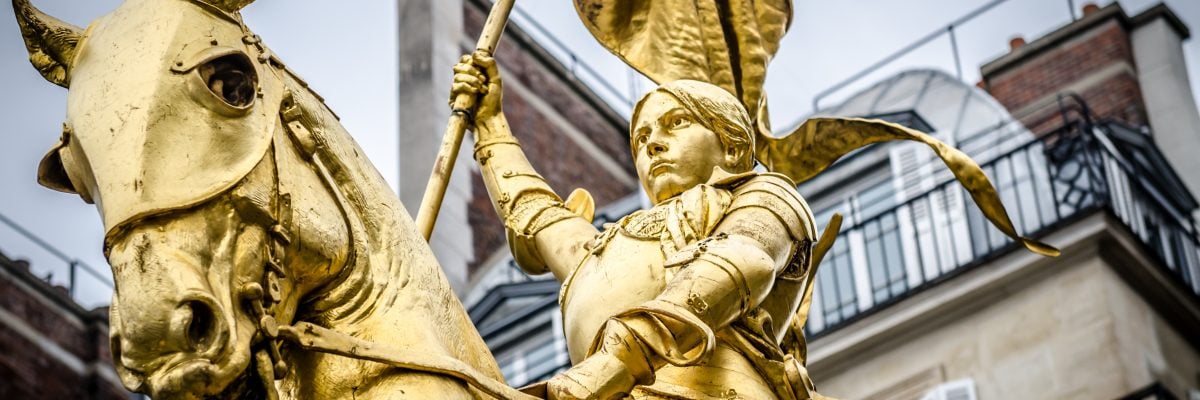
St. Joan of Arc bore with saintly virtue many indignities in her short life of service to God and country. Nearly six centuries later, those indignities have been renewed. In mid-August, a wave of iconoclasm swept the United States in the wake of a rally of assorted white nationalists and neo-Nazis in Charlottesville, Virginia, organized ostensibly (and disingenuously) to protest the proposed removal of an equestrian statue of Confederate Gen. Robert E. Lee from a public park. (Disingenuously because Lee was not a nationalist, and Hitler, whom the neo-Nazis revere, praised Abraham Lincoln and damned the Confederacy in Mein Kampf for the same reasons Marx and Engels had done.) As local and state governments began to remove Confederate monuments from public spaces, some private citizens took it on themselves to accelerate the process, and in the excesses of their zeal vandalized a New Orleans statue of St. Joan astride a horse.
The few national news stories that took note of the desecration of Joan’s image chalked it up to an unfortunate case of mistaken identity. They patiently explained that Joan, who had dressed as a man to avoid detection while traveling through enemy territory on her divine mission to lead troops into battle in defense of her homeland, had been mistaken by the vandals for a cavalier general of the Confederate States of America. The problem was ignorance, not hatred of Joan or of Christian symbols. How could the well-meaning vandals, bravely attacking a statue in the dark of night, be expected to distinguish a monument to the Maid of Orléans from one to, say, J.E.B. Stuart?
A similar attack on a statue of St. Junipero Serra in California around the same time presented a different problem for the national media. Like St. Joan, Fr. Serra played no role in the American Civil War; Joan was burned at the stake in 1431 in France, and Serra died in 1787 in California, likely from tuberculosis he contracted from the natives he evangelized and served. That did not prevent vandals from pouring red paint over the head of his statue, scrawling “Murderer” across his chest (a charge never before leveled at the saint), and, perversely, painting a swastika on the statue of the young Native American on whose shoulder Fr. Serra’s hand rests.
Yet this time, the media did not chalk up the attack to ignorance but attempted to offer a sympathetic explanation. Although it’s true that Serra was no Confederate, the saint has been accused of exploitation of natives, even though the historical record shows that he, like other Franciscan missionaries in California, vigorously opposed the abuse of natives by elements of the Spanish colonial government—even traveling 2,000 miles in 1773 to plead successfully on their behalf to the Spanish viceroy in Mexico City. Such fine distinctions are lost in the current hysteria, in which all of mankind must be placed into one of two classes: oppressor or oppressed. Whether Antifa or neo-Nazi, the narrative is the same; the only difference lies in the identities of the putative oppressors and oppressed.
The near-universal acceptance of this narrative across the entire political spectrum is the reason why those who say the iconoclasts will not stop with statues of Confederate generals and soldiers but will move on to Washington and Jefferson, Andrew Jackson and Teddy Roosevelt (not to mention Christopher Columbus), will almost certainly be proven correct. Even memorials to the great Union general William Tecumseh Sherman will not be safe—not, of course, because of his actions during the war in the March to the Sea, but because of his later role as commanding general of the U.S. Army during the Indian Wars. The Great Emancipator himself will eventually come under attack; Abraham Lincoln’s views on race put him well outside the accepted views of today.
None of this is a surprise. The iconoclasm of ideology—the elevation of the purity of abstract political principle over the complexity of the history of fallen man—has been a feature of the modern world since the French Revolution. What is a surprise, over 200 years later, is how few Christians see this iconoclasm for what it is: an assault on the dignity of man, with all of his faults and all of his splendors, and ultimately on the God whose image all men, no matter how far fallen, still retain.
The revolutionaries of Jacobin France knew what they were doing. Like Hitler and Stalin, like the neo-Nazis and Antifa of Charlottesville—their ideological descendants and brothers under the skin—the revolutionaries understood that imposing an abstract unity on the people of France required the exclusion and even the death of those who threatened that unity. And not just that: their distorted view of the world required the death of the Christian God himself, because in the very nature of the Trinity we see the value of diversity as well as of unity. Since they could not kill him directly, the revolutionaries did the next best thing: they burned churches, sacrificed Christians on the altars of our Lord, smashed stained-glass windows, tore down crucifixes, and destroyed statues. And even as they filled mass graves with the bodies of the faithful, they dug up the bodies of priests and burned their bones along with the relics of the saints.
They did it all, of course, in the sure and certain knowledge that they were pure, and the symbols and the people they attacked were not. As Thomas Aquinas reminds us, no person chooses evil because it is evil; he chooses it because of a perverted sense of the good—and that is as true of the modern iconoclastic ideologue as it is of each one of us when we sin. The difference is that the sinner, pricked by a properly formed conscience, may repent of his sin; but the ideologue continues to see himself surrounded by evil in the form of the symbols of the past and the faces of his fellow fallen men.
Where will it end? Only God knows. The mayor of Madison, Wisconsin has ordered the removal of monuments to Confederate soldiers who died in a prison camp there, installed in honor of a woman who tended their graves over a century ago in the city’s Forest Hill Cemetery. Each day a new line is crossed; how long before the bodies of the 140 men buried in Forest Hills will be deemed as unwelcome as the monuments to a Christian woman’s dedication to the graves of her ancestors?
It has happened before; it will happen again. There’s nothing new under the sun.



